The microscopic structure of wool fiber is very complex. Wool is the natural highly crimped textile fiber which obtained from a variety of sheep. Wool is possibly the oldest fiber of all fiber known to humans. For thousands of years, wool has been used for clothing and other purposes by different tribes and nations across the world. It was the first fiber that was spun into yarn and made into fabric. A sheep’s fleece is removed once every year by power operated clippers. There are many active side groups in the protein keratin that makes wool such a complex fiber. It is composed of many different molecules. In this article we will also described physical structure of wool fiber besides microscopic structure of wool fiber.
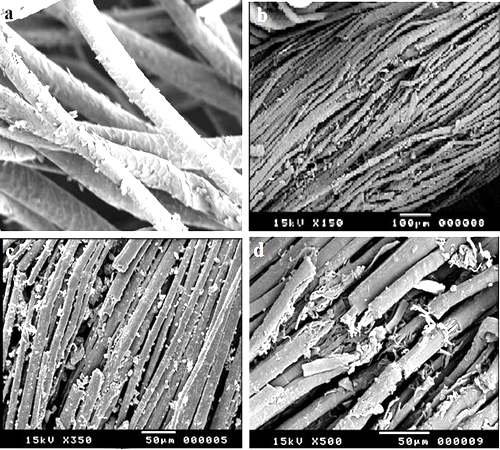
Physical Structure of Wool:
Physical structure of wool fiber is depend on a number of factors, such as physical condition of sheep, kinds of sheep, the part of the sheep from which the wool fiber is taken, as well as the manufacturing and finishing process. Physical structure of wool fiber is determined by its color, length, crimp, diameter etc. the color of wool fiber is white to light cream. According to the animal and the length of time between shearing, Merino wool fibers range in length from 1.5 to 5 inches. The average length of long, fine wool fibers used in worsted yarns is 2.5 inches. A worsted yarn has longer fibers and is more uniform in length after going through a coming process. Woolen fabrics are made from short fibers, which average 1.5 inches in length. Woolen describes a soft and loosely twisted yarn and implies shorter fibers, less uniform in length, and fewer parallel fibers. In specialty fabrics and hand weaving, certain sheep breeds produce coarse long wool (5 to 15 inches long). Wool fiber diameters can range from 10 to 50 micrometers, with Merino lamb wool averaging 15 micrometers. Wool fibers are complex, with a cuticle, cortex, and medulla.
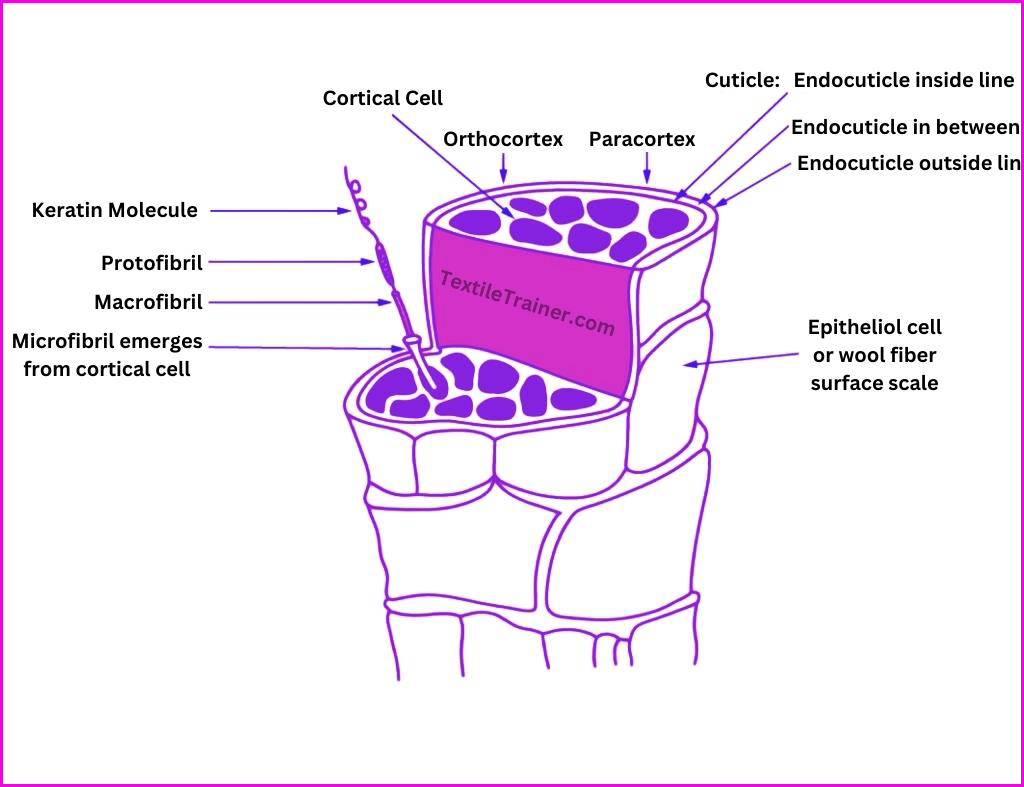
Morphology of wool/Microscopic Structure of Wool:
It is possible to describe the morphology of wool or microscopic structure of wool fiber in two different ways. One of them is the macro structure of wool, and the other is the micro structure of wool. In this section, morphology of wool or microscopic structure of wool, i.e, macro structure of wool and micro structure of wool will be respectively described:
Macro Structure of Wool:
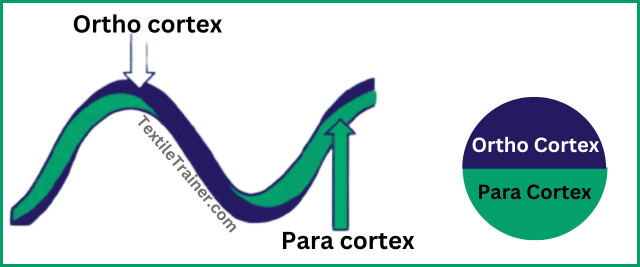
Wool is different from other fibers because of its bilateral chemical structure, which appears to be divided longitudinally into halves because of its structure, one side being called the paracortex and the other the ortho-cortex. In the para-cortex there are more cystine groups that crosslink molecules and are therefore more stable than in the orthocortex, resulting in a different chemical composition. Moreover, this difference between the orth and para cortex gives the fiber its spiral form. Furthermore, these two parts are affected differently by changes in atmospheric conditions, which causes wool to curl and twist spontaneously. The chemical nature of its structure determines its texture, elasticity, and staple.
Micro Structure of Wool:
Wool fibers consist of protein molecules. Similar to nylon, keratin proteins are actually crystalline copolymers, whose repeating units are amino acids. Also, disulfide bonds between wool fibers are present in the cystine amino acid. They are also crosslink through the cystine amino acid. The micro structure of wool fiber is composed of a cuticle, cortex, matrix, fibril and helical coil.
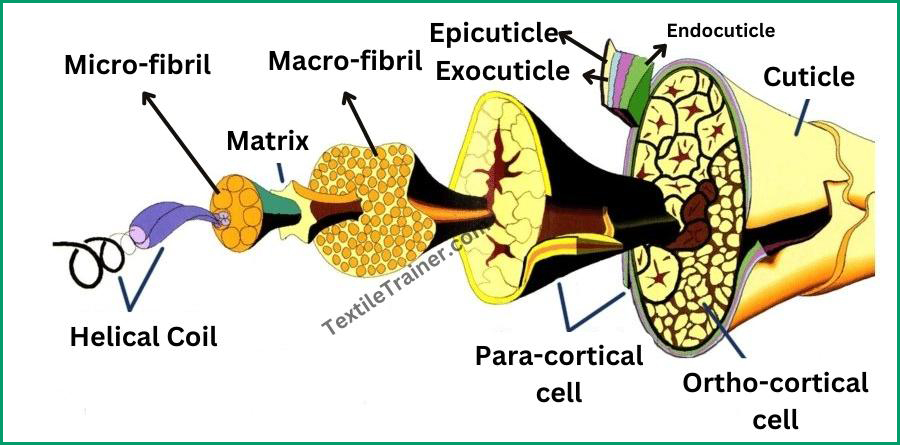
Cuticle:
Wool fibers have a unique surface structure consisting of overlapping cuticle cells, known as scales, under their outermost layer, which is referred to as the cuticle. Like human hair, the cuticle cells anchor the fiber to the sheep’s skin. These cuticle cells also provide the fiber with a tough exterior that protects it from damage. A waxy coating covers the wool cells, making it water repellent and the cuticle cells allow water vapour to pass through the fibers, so wool is comfortable to wear in all kinds of climates since the cuticle cells allow water vapour to pass through. The scales overlap on each other like tiles on a roof. The exposed edges of the cells point towards the tip of the fiber, creating a jagged edge that are able to expel dirt and also conducive to the felting process. There are times when wool felts are produced when the fibers of wool are aligned in opposite directions and they become entangled. This can be useful in outdoor clothing and upholstery fabrics, but can also result in an inconvenient situation when wool clothing is being over-washed. Cuticle consists of three parts.
- Epi-Cuticle: The outermost layer of wool fibre is the epicuticle.
- Exo-Cuticle: This is formed by overlapping epithelial cells.
- Endo-cuticle: The endocuticle is an intermediate connecting layer between the epithelial and cortex cells.
Cortex:
The cortex is the middle layer of the wool fiber and responsible for most of its mechanical properties. The cortex is made up of long, twisted chains of keratin, which gives it its strength and elasticity. It is highly organized and contains many small, air-filled spaces that help to keep the body warm. Based on the breed of sheep, the thickness and density of the cortex can differ, affecting the wool’s overall quality and characteristics.
There are two main types of cells in the cortex of a wool fiber: one is orthocortical cells and other is paracortical cells. each types of cortex has a slightly different chemical composition. A finer micron wool fiber is made up of two distinct halves of cells, while coarser wool has a less distinct arrangement. This difference in cell types, placed side by side, is responsible for wool’s natural crimp. As a result, the fiber bends due to the difference in the rate at which they expand when they absorb moisture. Hence, crimp is directly correlated with fiber diameter. Crimp makes wool feel soft and springy as well as add bulk and trap air between fibers, providing it with good insulation properties.
Macro fibril
In the cortex, there are long filaments known as macro fibrils. These are made up of bundles of even finer filaments known as micro fibrils, which are surrounded by a matrix region, which in turn contains smaller filaments of the same type.
Matrix
There is a high concentration of sulfur proteins in the matrix of wool. This gives wool the ability to absorb water because sulfur atoms attract water molecules. Wool can absorb up to 30% of its weight in water. It is also able to absorb without feeling wet. Wool is also capable of retaining large amounts of dye because the additional moisture content also helps wool resist static and is what makes wool the lowest ignition temperature, thus providing safer clothing and interiors.
Micro-fibril:
The matrix consists of smaller units called micro-fibrils, similar to steel rods embedded in reinforced concrete to give strength and flexibility. The micro-fibrils contains pairs molecular chains which is twisted.
Helical coil:
The helical coil, which is tightly coiled in the fibers of wool, is surrounded by the matrix. The helical structure of wool fibers that is makes the wool fibers more durable and resistant to breakage. The coils help to distribute stress and tension across the fiber, preventing it from snapping or fraying. Wool is therefore popular among textiles that require resilience and strength, such as clothing. This is one of the most important aspects of a fiber’s properties and versatility, and is of great importance to textile manufacturers, scientists, and environmentalists.
You May Read:
- History of wool with geographical distribution.
- Classification of wool fiber
- Sizing Easy Calculation.
Reference:
- Cook, J. G. (2005). Handbook of Textile Fibers. Delhi: WoodHead Publishing Limited.
- Corbman, B. P. (1987). Textile Fiber to Fabric. Singapore: McGraw Hill Book Co.
- Dr. Hosne Ara Begum, P. D. (n.d.). Natural fibers. Dhaka: Hafiz book center.
- Kaplan, N. (2006). Textile Fibres. New Delhi: Abhishek Publications.
- https://shop.britishwool.org. uk/the-structure-of-wool/
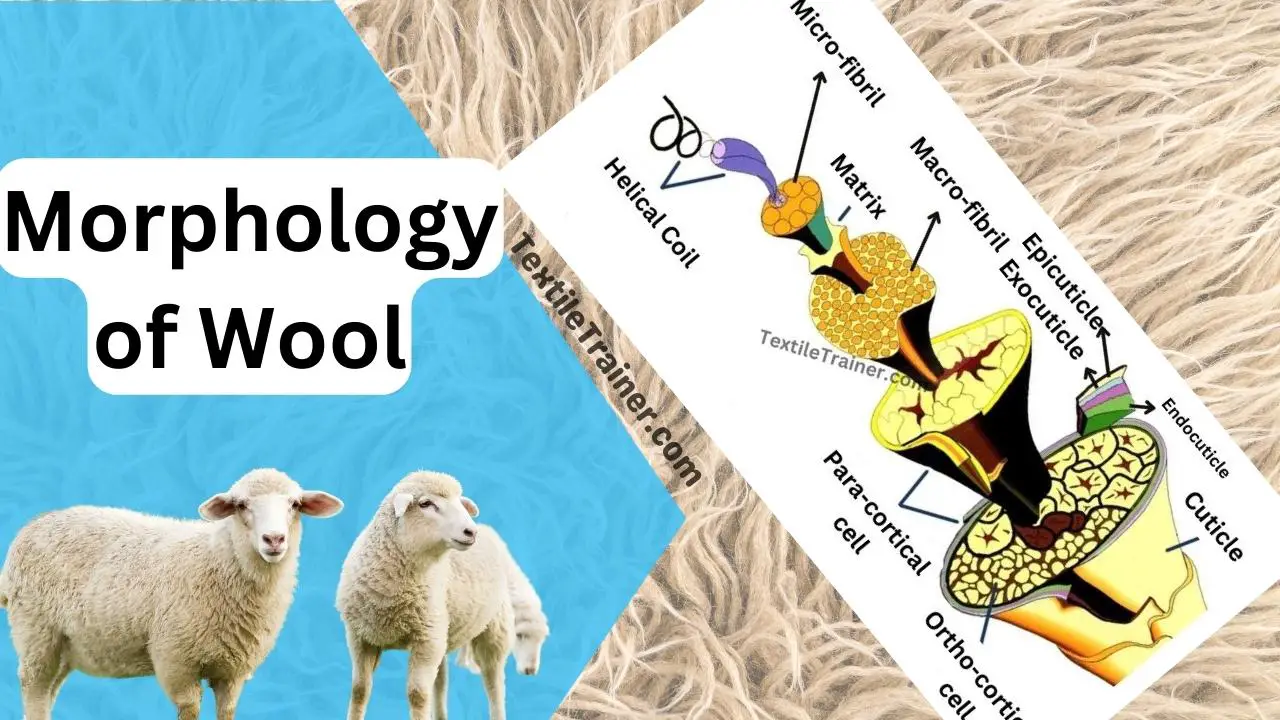
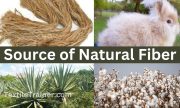

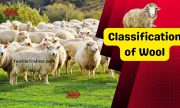
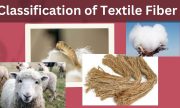

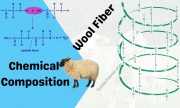
Thnnnxxx.
thanks too. please share our article with your friends and social media.
Thank you dear. Stay with us. Happy reading.